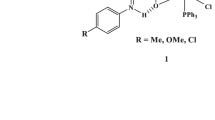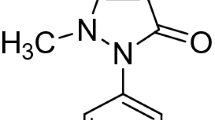Abstract
New metal complexes derived from the reaction of Cr(III), Mn(II), Fe(III), Co(II), Ni(II), Cu(II) and Zn(II) chlorides with the 2-imino-2H-chromene-3-carboximide organic ligand (HL) have been synthesized. The resulting complexes have been characterized by elemental analysis (CHN), IR, magnetic susceptibility, mass spectra, 1HNMR, UV–Vis, ESR, thermal analysis (TG, DTG and DTA) and molar conductance measurements. All the complexes are 1:2 and 1:3 electrolytes according to their molar conductivities. The microanalyses and spectroscopic data showed that the metal(II)/(III) ions in these complexes achieved coordination number of six and hence have octahedral geometrical structures. This is attained by bonding to the bidentate ligand via its two amino nitrogen atoms and two imine nitrogen atoms, and two monodentate aquo groups via its oxygen atoms. The results showed that the ligand acts as neutral bidentate coordinating via amino and NH nitrogens without displacement of hydrogen. The antimicrobial activities of the chromene ligand and its complexes have been tested against a number of pathogenic bacteria and fungi to assess their inhibiting potential. Antimicrobial studies indicate that these complexes exhibit better activity than the chromene ligand.
Graphical abstract




Similar content being viewed by others
References
El-Agrody AM, Abd El-Latif MS, El-Hady NA, Fakery AH, Bedair AH. Heteroaromatization with 4-hydroxycoumarin part II: synthesis of some new pyrano [2,3-d] pyrimidines, [1,2,4] triazolo [1,5-c] pyrimidines and pyrimido [1,6-b]-[1,2,4] triazine derivatives. Molecules. 2001;6:519–27.
Mazaahir K, Shilpi S, KhalilurRahman Khan M, Thukral SS. Aqua mediated synthesis of substituted 2-amino-4H-chromenes and in vitro study as antibacterial agents. Bioorg Med Chem Lett. 2005;15:4295–8.
El Azab IH, Abd El Latif FM. A simple and convenient synthesis of isolated-fused heterocycles based on: 2-imino-N-phenyl-2H-chromene-3-carboxamide. Open J Synth Theory Appl. 2012;1:44–57.
Andrea B, Nicole V, Jakob T, Sonja H, Stefan B, Christa EM. Synthesis and pharmacological evaluation of coumarin derivatives as cannabinoid receptor antagonists and inverse agonists. Bioorg Med Chem. 2009;17:2842–51.
Viselike P, Loannis KK, Panagiotis M, Nicole P, Loanna A. Synthesis and free radical scavenging activity of some new spiropyanocoumrins. Bioorg Med Chem Lett. 2008;18:5781–4.
Tadigoppula N, Tanvir K, Shweta N, Neena G, Suman G. Synthesis of chromenochalcones and evaluation of their in vitro antileishmanial activity. Bioorg Med Chem. 2005;13:6543–50.
William K, Shailaja K, Jiang SC, Zhang H, Zhao JH, Jia SJ, Xu LF, Crogan-Grundya C, Denis R, Barriault N, Vaillancourt L, Charron S, Dodd J, Attardo G, Labrecque D, Lamothe S, Gourdeau H, Tseng B, Drewea J, Cai SX. Discovery of 4-aryl-4H-chromenes as a new series of apoptosis inducers using a cell-and caspase-based high-throughput screening assay. 2. Structure–activity relationships of the 7- and 5-, 6-, 8- positions. Bioorg Med Chem Lett. 2005;15:4745–51.
Djnielle G, Samuel V, Vijay LM, Frederic C, Guillaume V, Florence M, Philippe J, Rene G. The synthesis of new, selected analogues of the pro-apoptotic and anticancer molecule HA14-1. Tetrahedron Lett. 2008;49:3276–8.
Yuran L, Lin W, Chen B, Xie Y. Development of FRET-based ratiometric fluorescent Cu2+ chemodosimeters and the applications for living cell imaging. Org Lett. 2012;14:432–5.
Reddie KG, Humphries WH, Bain CP, Payne CK, Kemp ML, Murthy N. Fluorescent coumarinthiol measure biological redox couples. Org Lett. 2012;14:680–3.
Ali TE, Abdel-Aziz SA, El-Shaaer HM, Hanafy FI, El-Fauomy AZ. Synthesis of some new 4-oxo-4H-chromene derivatives bearing nitrogen heterocyclic systems an antifungal agents. Turk J Chem. 2008;32:365–74.
El-Ansary AL, Kandil AT, Issa YM, Soliman MH. Effect of some surface active substances on the spectrophotometric determination of Th(IV) using some coumarinazo dyes. Asian J Chem. 1998;10:86–98.
Issa YM, El-Ansary AL, Sayed SA, Soliman MH. Spectrophotometric determination of thulium (III) and dioxouranium ions using 8-(aryl azo)-6,7-dihydroxy-4-methyl coumarinderivatives. Egypt J Chem. 1999;42:37–47.
Katyal M, Singh HB. Analytical applications of hydroxycoumarins. Talanta. 1968;15:1043–5.
Omar MM. Studies on the dissociation constants of some substituted coumarinazo dyes in mixed solvents. Egypt J Chem. 1993;36:189–98.
Ligia RG, John NL, Femando C, Fernanda B. The crystal structures of four N-(4-halophenyl)-4-oxo-4H-chromene-3-carboxamides. Acta Crystallogr E CrystallogrCommun. 2015;71:88–93.
Kose D, Oztufk B, Sahin O, Buyukgungor O. Mixed ligand complexes of coumarilic acid/nicotinamide with transition metal complexes. J Therm Anal Calorim. 2014;115(1):515–1524.
Elgemeie GEH, Elghandour AHH. Activated nitriles in heterocyclic synthesis. Novel synthesis of 5-Imino-5H-[1] benzopyrano[3,4-c] pyridine-4(3H)-thiones and their oxo analogues. Bull Chem Soc Jpn. 1990;63:1230–2.
Lorian. Antibiotic in Laboratory Medicine. In: Einstein A, editor. Bronx, New York: College of Medicine; 1980. p. 176.
Boyd RF. General microbiology times mirror. Toro: Mosby Collage Publishing; 1984.
Irving H, Williams RJP. The stability of transition metal complexes. J Chem Soc. 1953;320:3192–210.
Jones RD, Summerville DA, Basolo F. Synthetic oxygen carriers related to biological systems. Chem Rev. 1979;79:139–79.
Mohamed GG, Soliman MH. Synthesis, spectroscopic and thermal characterization of sulpiride complexes of iron, manganese, copper, cobalt, nickel and zinc salts. Antibacterial and antifungal activity. Spectrochim Acta Part A. 2010;76:341–7.
Praveen Kumar S, Suresh R, Giribabu K, Manigandan R, Munusamy S, Muthamizh S, Narayanan V. Synthesis and characterization of chromium(III) Schiff base complexes: antimicrobial activity and its electrocatalytic sensing ability of catechol. Spectrochim Acta Part A. 2015;139:431–41.
Cotton FA, Wilkinson G, Murillo CA, Bochmann M. Advanced inorganic chemistry. 6th ed. New York: Wiley; 1999.
Mahmoud WH, Mohamed GG, El-Dessouky MMI. Coordination modes of bidentatelornoxicam drug with some transition metal ions. Synthesis, characterization and in vitro antimicrobial and antibreastic cancer activity studies. Spectrochim Acta A. 2014;122:598–608.
Soliman MH, Mohamed GG, Hindy AMM. Biological activity, spectral and thermal characterization of mixed ligand complexes of enrofloxacin and glycine: in vitro antibacterial and antifungal activity studies. Monatsh Chem. 2015;146:259–73.
Soliman MH, Hindy AMM, Mohamed GG. Thermal decomposition and biological activity studies of some transition metal complexes derived from mixed ligands sparfloxacin and glycine. Therm Anal Calorim. 2014;115:987–1001.
Mahmoud WH, Mohamed GG, El-Dessouky MMI. Synthesis, structural characterization, in vitro antimicrobial and anticancer activity studies of ternary metal complexes containing glycine amino acid and anti-inflammatory drug lornoxicam. Mol Struc. 2015;1082(1082):12–22.
Mohamed GG, Zayed MA, El-Gamel NEA. Preparation, chemical characterization and electronic spectra of 6-(2-pyridylazo)-3-acetamidophenol and its metal complexes. Spectrosc Lett. 2000;33:821–32.
Mahmoud WH, Mahmoud NF, Mohamed GG, El-Bindary AA, El-Sonbati AZ. Supramolecular structural, thermal properties and biological activity of 3-(2-methoxyphenoxy) propane-1,2-diol metal complexes. Mol Struc. 2015;1086:266–75.
Ali MA, Majumder SMMH, Butcher RJ, Jasinski JP, Jasinski JM. The preparation and characterization of bis-chelated nikel (II) complexes of the 6-methylpyridine-2-carboxaldehyde Schiff bases of S-alkyldithiocarbazates and the X-ray crystal structure of the bis {S-methyl-B-N-(6-methylpyrid-2-yl)-methylenedithiocarbazato}nickel(II) complex. Polyhedron. 1997;16:2749–54.
Zianna A, Ristović MS, Hatzidimitriou A, Papadopoulos CD, Kantouri ML. Synthesis, thermal analysis, and spectroscopic and structural characterizations of tetra nuclear nickel(II) cubane-type clusters with 2-hydroxybenzaldehydes or 2-hydroxyphenones. J Therm Anal Calorim. 2014;118(3):1431–40.
Mohamed GG, Nour EL-Dien FA, Khalil SM, Mohammad AS. Metal complexes of omeprazole. Preparation, spectroscopic and thermal characterization and biological activity. J Coord Chem. 2009;62:645–54.
Refat MS, Mohamed GG. Ti(IV), Cr(III), Mn(II) and Ni(II) complexes of the norfloxacin antibiotic drug: spectroscopic and thermal characterizations. J Chem Eng Data. 2010;55:3239–46.
Mahmoud WH, Mohamed GG, El-Dessouky MMI. Synthesis, characterization and in vitro biological activity of mixed transition metal complexes of lornoxicam with 1, 10-phenanthroline. Int J Electrochem Sci. 2014;9:1415–38.
Mohamed GG, Zayed EM, Hindy AMM. Coordination behavior of new bis Schiff base ligand derived from 2-furan carboxaldehyde and propane-1,3-diamine. Spectroscopic, thermal, anticancer and antibacterial activity studies. Spectrochim Acta A. 2015;145:76–84.
Lever ABP. Inorganic electronic spectroscopy. New York: Elsevier; 1968.
El-Sonbati AZ, Diab MA, El-Bindary AA, Mohamed GG, Morgan SM. Thermal, spectroscopic studies and hydrogen bonding in supra molecular assembly of azo rhodanine complexes. Inorg Chim Acta. 2015;430:96–107.
Dean JA. Langes hand book of chemistry. 14th ed. New York: McGraw-Hill; 1992.
Nakamoto K. Infrared spectra of inorganic and coordination compounds. New York: Wiley; 1970.
Ferraro JR. Low frequency vibrations of inorganic and coordination compounds. New York: Plenum Press; 1971.
Hathaway BJ, Billing DE. The electronic properties and stereochemistry of mono-nuclear complexes of the copper(II) ion. Coord Chem Rev. 1970;5:143–207.
Hathaway BJ. A new look at the stereochemistry and electronic properties of complexes of the copper (II) ion. Struct Bond. 1984;57:55–118.
Gudasi KB, Patil SA, Vadavi RS, Shenoy RV. Crystal structure of 2-[2-hydroxy-3-methoxyphenyl]-3-[2-hydroxy-3-methoxybenzylamino]-1,2dihydroquinazolin-4(3H)-one and the synthesis, spectral and thermal investigation of its transition metal complexes. Trans Met Chem. 2006;31:586–92.
Tweedy BG. Plant extracts with metal ions as potential antimicrobial agents. Phytopathology. 1964;55:910–4.
Singh Jadon SC, Gupta N, Singh RV. Synthetic and biochemical-studies of some hydrazine carbodithioic acid-derivatives of dioxomolybdenum(VI). Ind J Chem. 1995;34A:733–6.
Pelczar MJ, Chan ECS, Krieg NR. Microbiology. 5th ed. New York: McGraw-Hill; 1998.
Krajníková A, Rotaru A, Győryová K, Homzová K, Manolea HO, Kovářová J, Daniela Hudecová D. Thermal behaviour and antimicrobial assay of some new zinc(II) 2-aminobenzoate complex compounds with bioactive ligands. J Therm Anal Calorim. 2015;120(1):73–83.
Homzová K, Győryová K, Bujdošová Z, Hudecová D, Ganajová M, Vargová Z, Kovářová J. Synthesis, thermal, spectral and biological properties of zinc(II) 4-hydroxybenzoate complexes. J Therm Anal Calorim. 2014;116(1):77–91.
Acknowledgements
The authors wish to express their deep thank for Ms/Salma Ahmed for carrying out the biological activity study in this work.
Author information
Authors and Affiliations
Corresponding author
Rights and permissions
About this article
Cite this article
Soliman, M.H., Mohamed, G.G. & Elgemeie, G.H. Novel synthesis of 2-imino-2H-chromene-3-carboximide metal complexes. J Therm Anal Calorim 123, 583–594 (2016). https://doi.org/10.1007/s10973-015-4975-4
Received:
Accepted:
Published:
Issue Date:
DOI: https://doi.org/10.1007/s10973-015-4975-4




